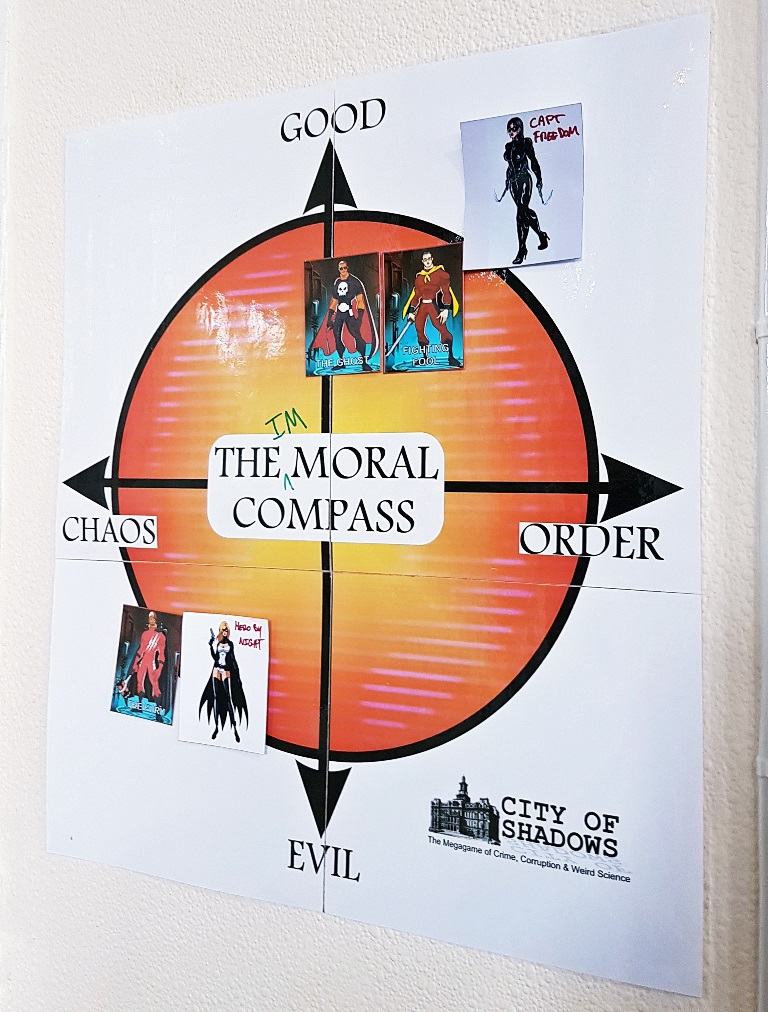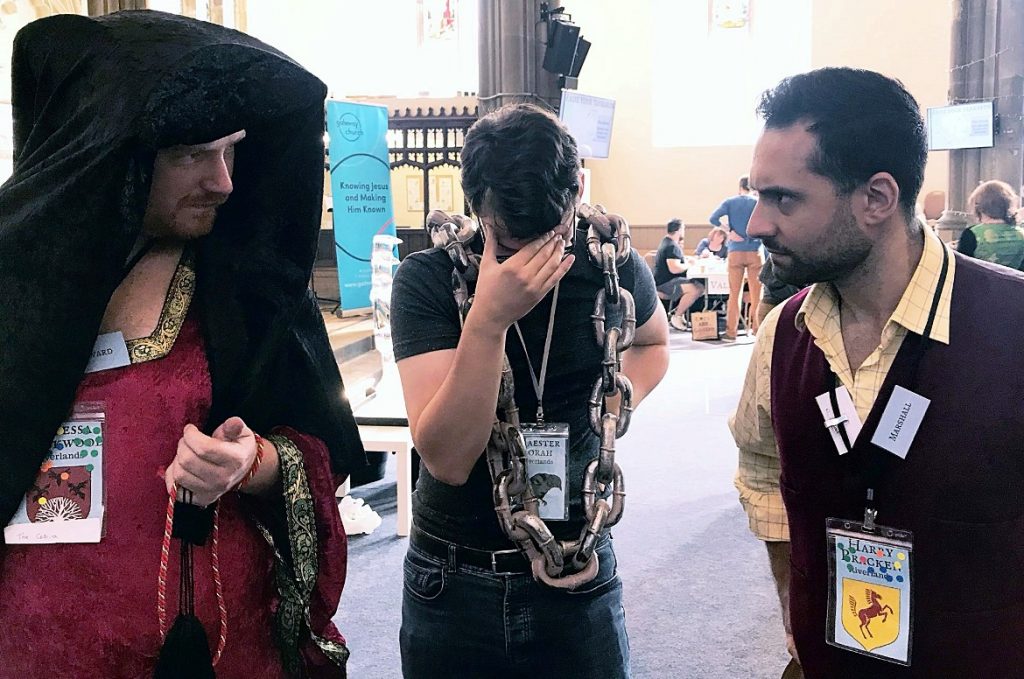For some people, this is the reason they write megagames, the part they find most enjoyable. For others, this is a necessary evil. I’m definitely more in camp one than camp two, but that doesn’t mean I don’t understand the challenges surrounding the briefing part of megagame design.
For the purposes of this post, I’m referring to any written material in a megagame excluding mechanics – so team briefings, personal briefings and setting materials, not handbooks or cheat sheets.
Note: I have provided some PDF files relating to games I have run in the past within this blog post. Please feel free to download them and take them as inspiration for your own games. However, please do not redistribute or use them directly in your games (not that they’d be much use without the rest of the game materials). If you would like to discuss licensing either Everybody Dies or Trope High, then get in touch.
The purpose of briefings
So you’ve created your awesome world for your game. You, obviously, know it inside out, and any part of the world which you don’t automatically know about you can invent. But your players know nothing. So that’s the purpose of briefings – to bring your players’ (and Controls’) knowledge of the world closer to your own.
In an ideal world, you’ll be able to make sure all your players are fully immersed and knowledgeable about your game world, as if it was a long-running TV show they were obsessed with. But in reality, the majority of players will spend maybe an hour or two preparing for your game, and might watch one movie related to your game.
When creating your briefings, consider what the most important information to get across is. Your players can’t become experts in the same way as you. Your world should be as fleshed out as possible for yourself – it will make it easier for you to make quick decisions on the day when players come up with wizard wheezes – but when writing briefings you need to focus on what will make the most impact for players.
Setting, Team, Individual?
Some games won’t have all of these in, though all games should have at least one briefing document, probably two. Even if you’re running a very roleplay-light game set in the real world, you will still need team briefings to lay out the different objectives for players.
Setting
This document lays out the world your game will be inhabiting. It’s your opportunity, as a designer, to make sure all your players are starting on the same page. It is always completely public for all players – anything more specific, I would categorise under team briefings below.
If you’re setting it on modern day Earth, you might not need this. But even if you are, it might be useful to do a half page of “known facts”. If America is in the game, is Trump president? If your game introduces supernaturals such as aliens or zombies, is there any existing knowledge of them, besides common folklore? The further away you get from a westernised 2019 view (assuming you’re running your games in the UK), the more you will need to explain.

At the other end of the spectrum, if you’ve created a completely original setting, you will be struggling with the opposite problem – how much setting material is too much?
There’s no one answer to that question. There will always be players that don’t read any of it, after all. But the more you write, the more likely players will skip or skim. And the more engaging you need to make your writing, to keep them reading.
And if your game world falls somewhere in between, then so does your briefing requirement. But there’s no definitive “real world = 1 page, bespoke world = 10 pages max” formula. The only real guidance I can give you is to make it as concise as possible without compromising on quality. Cut out anything that isn’t definitely adding to the briefing.
In Everybody Dies, I had a file called Life in Westeros, which was a guide to the world for anyone who hasn’t read the books / seen the show – details like “the North is massive and sparsely populated” and “no man is as accursed as the kinslayer”. This doc was 10 pages long, but anyone interested in Game of Thrones could have easily skimmed it. There was also A Brief History of Westeros, which was more important for players to read, as it included the political history that had let to the current situation at the start of each game. This one was four pages.
At Trope High, since the world was a more logical and familiar one, the setting briefing was correspondingly shorter at four pages. It was also a completely IC document – a school prospectus annotated by the previous year’s Yearbook Committee.
Team
Depending on your game, this might be the focus of your briefing material. A team briefing is given to all players on a particular team, and may either be private to that team or publicly available for others to view, dependent entirely on what it contains and who the team is.
You may also have several levels of briefings. At Everybody Dies, there were public team briefings for each region, as well as private ones for the maesters, religious players and bards (although these were actually folded into their mechanics handbooks). In ED3, there were also additional Black/Green briefings which laid out the political viewpoints of anyone on that team.
At Trope High, there were no team briefings for student players. The teacher briefing was folded into the teacher handbook.
Individual
Finally, there’s individual briefings. Not every game has them, but personally I prefer the games where players have even just a line or two of personal opinions and objectives. It encourages players on the same time to pull in different directions and have different priorities, which increases the tensions within the game.

Individual briefings may include a short (or more extensive) backstory to character, two or three personal objectives, any stats that the player has, and any significant relationships.
In Everybody Dies individual briefings were 2-4 pages long, and included a comprehensive personal history, detailed relationships and three personal objectives – and I tried to make the backstories just as compelling for original characters as for GRRM’s own ones. Meanwhile, the Trope High briefings were a page of A4, but very visual. The first page contained personal mechanics, aims, stats relating to their character and single word relationships for Best Friend, Rival and Crush. The second page was a short backstory.
Never underestimate the power that fairly insignificant details can have in your briefings. The Best Friends, Rivals and Crushes were a really last minute addition to the character sheets at Trope, yet so much of the game centred around these relationships.
Tone
The tone of your briefings is another important thing to consider. Is this an in-world document, that the characters in your game may legitimately read, such as the School Prospectus for Trope High? Is it an out of character briefing because you need to explain concepts that will be difficult for players to understand, such as the emotional investment in religion in Renaissance Europe? Both types of piece have their place.
In my opinion, if you can get away with writing IC, then do so! But if there’s any ambiguity, then it’s best to stick with OOC.
Mechanics
Should briefing materials have mechanics in? Or should they always be in the handbook? You should frontload as much of your mechanics into the handbook as possible, but for short mechanics that only affect a single player or small subset, it might make sense to include them on team or individual briefings rather than creating a separate handbook containing those rules.
As always, it’s a judgement call, and there’s nothing inherently bad about including mechanics on briefings – I did it at Trope, after all!
Timing
When should you send out your briefing materials? Well, for setting guides, as early as possible. Ideally have them available on your signup page as soon as you start marketing, or as soon as the doc is ready. Failing that, send them out with your main handbook.
Team briefings can be sent out later, and often are. If the contents of them are secret then when players have seen private briefings it makes it harder to switch up the cast list in case of dropouts.
Individual briefings are often sent later still, or even given on the game day itself. If you do decide to give them out on the day, make sure you keep them short as players will want to get into the swing of the day asap. Additionally, you should bear in mind that players may have devised plans and strategies that completely oppose the briefing you have just given them, and they may not sacrifice this plans completely (or at all!).
Do players read briefing materials?
They should! I believe that the briefing materials are one of the key parts of the megagaming experience that set it apart from board games, and so many of the interesting interactions within games arise from briefings rather than rules.

However sometimes players don’t exactly do what we want them to do, myself included. I often have the best intentions to read briefings and handbooks at least a week before the game, and it often still ends up with me cramming them in on the train to the venue. And I’ve heard rumours of some players who don’t read a single thing before they turn up.
What can a designer do about this? Dripfeeding setting information through social media and emails is one way to combat it, but obviously you can’t do that with secret information or personal briefings. Keeping it as concise as possible will help you with the last-minute readers, but generally you just have to accept it.
Control
When planning all this, don’t forget about Control! Again, in that ideal world we keep talking about, Control will have the time and inclination to not only read but memorise the briefings for any players they’ll be managing on the day. But practically, you should be created short summaries of player briefings for your Control. This will minimise the prep work they have to do as well as giving them a handy sheet to refer to on game day.
It’s also a good idea to write a setting briefing for your Control Team, as you might want to explain some decisions that you’ve made for the world – for example, if a recent ruler has died, the players might not know who killed them, but Control certainly should! If there’s secret information in the game, you should also give Control some guidance as to how secret it is – should a spy mission be able to find out this info? Or is it game-changing catastrophic if it gets out before 3pm?
Format
One final piece of advice – ALWAYS save your briefings as PDFs before you send them out! Unlike Word docs, they can be opened on any device, and a lot of people will be reading your briefings on their phones. For this reason, I also often converted my briefings to A5 rather than A4, as it makes the text bigger on mobile.
It’s also a good idea to give your materials consistent styling, and if you’re really into it, use fonts that are evocative of your game world. It’s minor details, but for visually-minded players it can really help them get into the feel of your universe.
What tips do you have for writing briefings?
Others in the “How to Write a Megagame” series
Part 1: Choosing Your Concept
Part 2: Logistics
Part 3: Scoping
Part 4: Mechanics
Part 5: Briefings
Part 6: Secret Plots
Part 7: Casting
Part 8: Teams
Part 9: Control and Facilitators
Part 10: Venues (coming soon)
